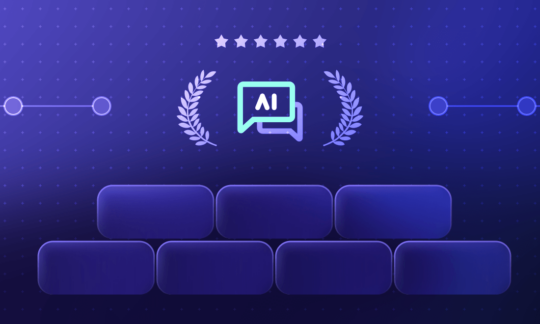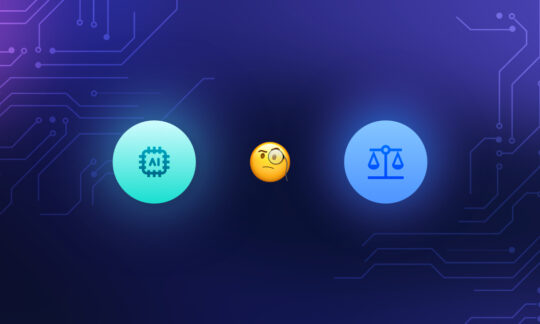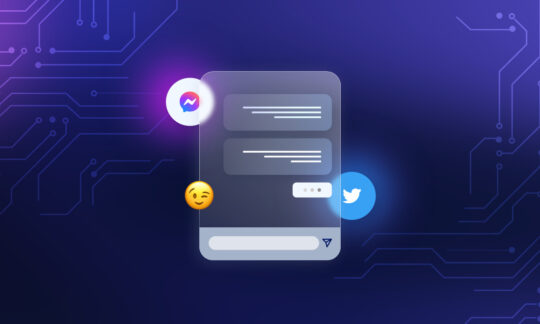Transforming Citizen Services – Chatbots for Government
Table of contents
- What Are Chatbots?
- The Many Use Cases for Chatbots in Government Service
- Improving Citizen Support – The Benefits of Chatbots for Government Services
- Cons or Considerations for Using Chatbots in Government
- Serving Citizens – Government Chatbot Examples
- Leverage AI to Transform Your Government Support Services
What Are Chatbots?
“hi, I’m Phil, your virtual assistant. What can I help you with today?”
It seems like every other website you visit these days has a chatbot popping up with a similar message. The term “chatbot” has increasingly become part of common language, but what is a chatbot really? Despite the human names often given them, a chatbot is, at it’s core, software designed to interpret messages from humans in order to provide support or solve problems.
There’s a few layers to that. Chatbots need to interpret language, to derive meaning from a string of text characters or spoken syllables. Chatbots use natural language processing capabilities to interpret the incoming messages. Chatbots also need to associate those incoming questions or requests with responses that are relevant and helpful. This can be achieved through rule-based routines, but for more complex topics an additional layer of artificial intelligence is used to deliver an appropriate response.
In this post we’ll take a look at how chatbots can help city, state and federal government agencies more effectively service their constituents.
The Many Use Cases for Chatbots in Government Service
While chatbots have their roots in the private sector, public officials are growing increasingly aware of the many beneficial use cases of government chatbots. The 2020 Center for Digital Government Surveys found significant activity and interest around chatbots at all levels. Among city and county governments, roughly 2/3rds responded that they are either using chatbots currently or plan to within the next 12-18 months. Among state-level respondents, this figure rose to a full 100%.
Chatbots can help respond to public needs by offering fast and effective support of common requests or information needs. This is most evident in areas where the government has exclusive access to information that is useful to a large group of people. Within the government sector, that can include:
- Public health information, such as COVID-related questions
- Tax information, like filing deadlines or forms
- Unemployment insurance details and application procedures
- Transit, including routes and scheduling
- Immigration, including application status updates
- Permits, for business and individuals
- City events, such as festivals
Improving Citizen Support – The Benefits of Chatbots for Government Services
Governments, on a limited budget, are tasked with providing a tremendous range of service capabilities. Unlike private businesses which have the luxury of focusing their service attention on a particular group of customers, governments are tasked with serving every adult within their jurisdiction.
The highest-impact benefit for government chatbots is improving response times for common service tasks. Chatbots are a great solution for the scenario of a person with a simple, account-specific inquiry who has to wait in a lengthy phone support queue. There are numerous examples (several cited below) of government agencies dramatically reducing response times through chatbot support. Chatbot responses are fast and consistent, and available 24/7.
There are many additional benefits governments can gain from employing chatbots, including:
- Reduced staffing and training costs: Chatbots can dramatically reduce call center staffing costs.
- Improved employee morale and retention: Freeing employees from repetitive service tasks allows them to focus on more complex customer needs.
- Multichannel access: An ongoing challenge for government agencies is reaching their audience. Chatbots easily integrate with multiple digital channels, allowing governments to share important information in whatever channel the public is using. That can include the web, text, social media, messenging apps, or voice assistants.
- Multilanguage support: Chatbots can potentially speak several languages, helping reduce accessibility barriers.
- Logging and data mining: On the back-end, chatbots offer integrated logging and tracking of service tickets, allowing government teams to analyze trends and patterns, and further optimize the chatbot service for the public’s most pressing needs.
Cons or Considerations for Using Chatbots in Government
When introducing new technology, there are always some areas to tread carefully. For government teams considering chatbots, bear these factors in mind:
- Chatbots are limited by available data: People love epic technology fails – and in the past few years the media has delighted in high-profile chatbots that provide ludicrous or embarrassing answers. It’s important to remember that these mishaps generally involve chatbots proposing to answer anything, often based on data fed from millions of online conversations covering 1,000s of topics. The reality is the familiar “garbage in, garbage out” analogy. In situations with a clear business purpose, chatbots won’t veer off into abstract territory.
- Chatbots aren’t human: Chatbots can’t be expected to deliver the warm and fuzzy impression associated with a helpful and spontaneous human who is helping you out over the phone. They are not emotive, personal or spontaneous. While chatbots can be incredibly efficient at task-based support, government agencies that deal with sensitive or emotional issues (e.g. social services) should have a process for addressing the unique sensitivities of their audience.
- Government integrations can be complex: While some of the examples below were developed and launched in less than a week, government teams do need to consider whether the chatbot will collect any personally identifiable information, integration with other government systems, and whether it needs a FedRAMP authorization.
Serving Citizens – Government Chatbot Examples
City Government Chatbots
There are many examples of chatbots in local government helping inform and administer vital city services. Here are some examples:
San Francisco’s Office of Contract Administration designed their chatbot, PAIGE, to offer IT procurement support for employees. The designers estimate that PAIGE can answer about 80% of the questions asked about procurement procedures.
Kansas City’s chatbot is available on the City’s website and Facebook Messenger. The chatbot handles services such as permits, reporting maintenance issues, or paying utility bills. Requests can be submitted directly through the chatbot interface.
Looking further internationally, Dubai’s Electricity & Water Authority launched a chatbot called Rammas. It speaks both English and Arabic, and can be accessed via the web, iOS, Android, Amazon Alexa, Facebook, and a physical robot. Rammas has led to a reduction in customer response time by 97%, processing over 6.8 million enquiries since its launch in May, 2017.
The government agency Travel for London launched their Travelbot on Facebook in 2017. The chatbot provides support for bus arrivals, route status, service updates, and maps. Travelbot has had over one million conversations with over 150,000 people.
Government Chatbots used by County Governments
King County, Washington used a chatbot during the height of the pandemic to help residents screen for coronavirus-like symptoms. By filtering asymptomatic symptoms from symptomatic people, the county estimated that the chatbot saved 35% of the time nurses would have spent assisting those without symptoms.
Placer County, California has a bot called Ask Placer that can answer more than 375 questions.
Cabarrus County in North Carolina launched a chatbot integrated with their content management system to make a wide variety of documents accessible to their residents.
Government Chatbots used by State Governments
The National Association of State Chief Information Officers (NASCIO) lists 35 US States already using chatbots or virtual assistants to improve citizen services.
The Texas Workforce Commission created a chatbot, Larry, to handle frequently asked questions. Larry, which took just four days to develop, has since handled 4.8 million questions from 1.2 million Texans. The State of Minnesota also launched a chatbot dedicated to common questions. It’s estimated to have saved 1,700 hours of staff time.
Connecticut used a COVID chatbot that logged 40,000 interactions over just four months in 2021. The State estimates that it did the work of four full-time employees during that span.
Tax and driver licensing are often a key service area handled by government chatbots. In Missouri, DORA answered 100,000 resident questions about taxes, driver’s licenses and motor vehicles in the three months after it launched in November 2019. North Carolina’s myNCDMV chatbot allows residents to register new vehicles, renew registration and driver’s licenses, order license plates, register to vote, and update their address. The State estimates that the new digital workflows have generated a 25% increase in online revenue collection and a 40% shorter wait at DMV offices. In Mississippi, the Missi chatbot helps with public services info like taxation, health services, public transport, elderly care centers, social gatherings, tourism hotspots, family services, and job opportunities.
Government Chatbots used by Federal Government Agencies
USA.gov built AskTSA (on Twitter and Facebook) to answer questions from people on their way to board a plane. Queries that would have included a 1.5-hour wait over the phone can be answered almost instantly.
The Department of Home Land Security launched EMMA to help with immigration, green cards, passports and other services. Available in Spanish or English and accessed by text or voice commands, EMMA handles over one million interactions a month.
The Government of Singapore’s Ministry of Communications and Information (MCI) launched a chatbot through Facebook Messenger. It allows citizens to easily locate information about the government’s agencies, news, press releases, workforce, and policies.
Leverage AI to Transform Your Government Support Services
SentiOne can automate over 40% of repetitive tasks or customer requests. SentiOne’s AI bots allow governments to:
- Deploy both on-premises and in the cloud
- Integrate with several digital channels, CRM, and call centers
- Design sophisticated conversation models using a drag-and-drop interface – no code required!
- Achieve 94% intent accuracy recognition
- Analyze metrics such as average handling time, resolution time and more
Harness the power of AI to offer improved service to your constituents. Book a demo to see SentiOne’s AI bots in action.



